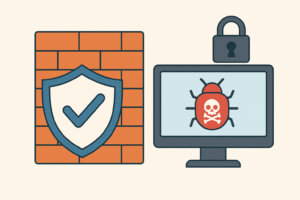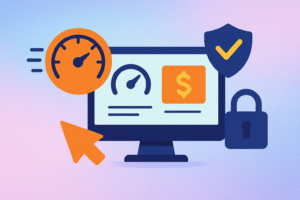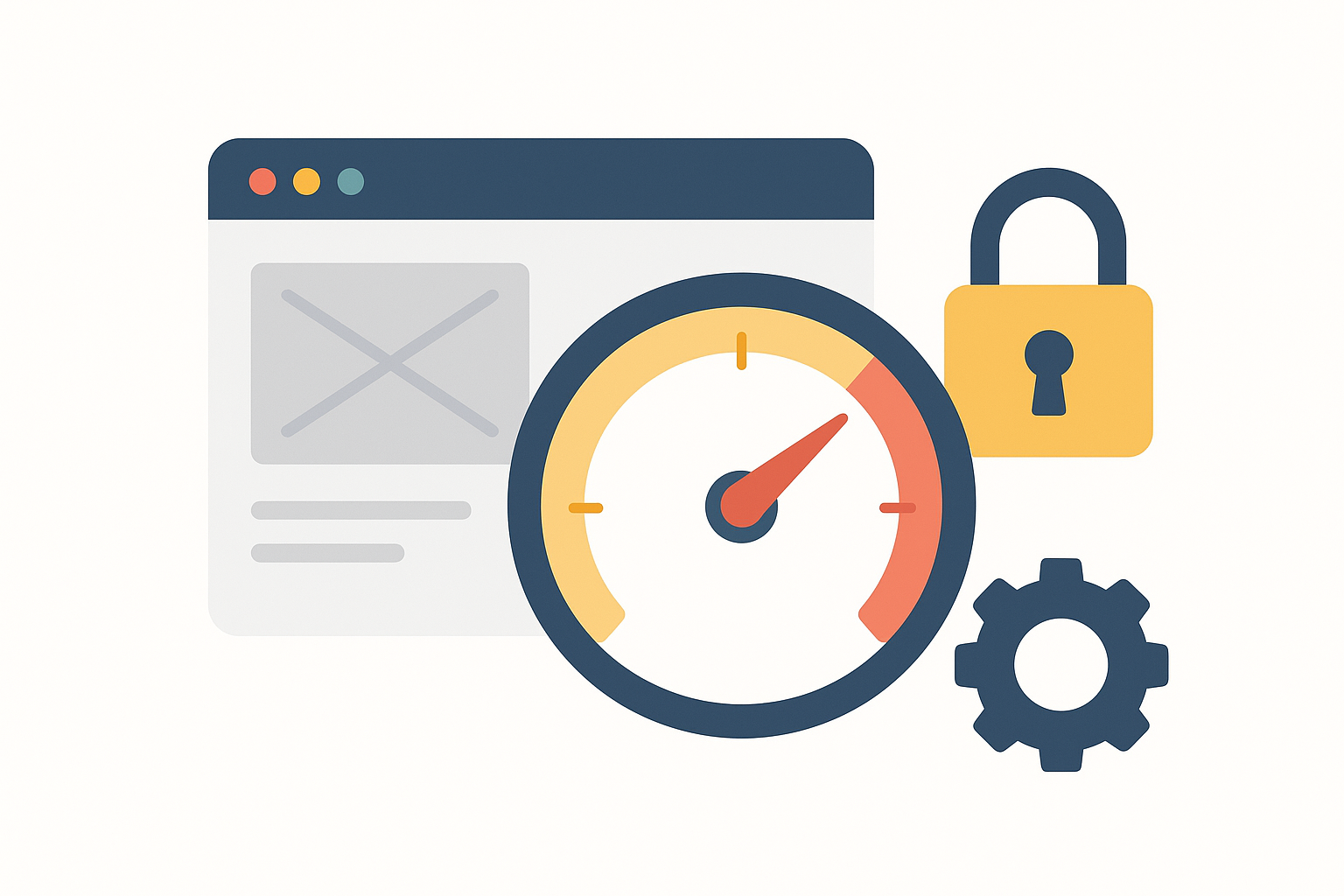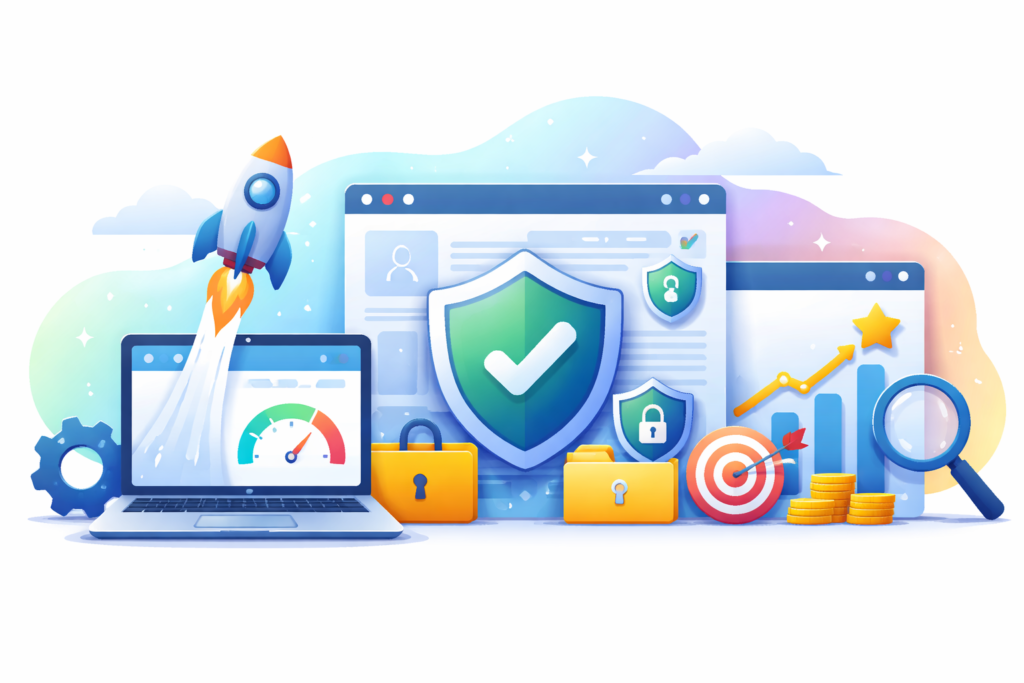In today’s competitive online world, a website speed and security optimization service is not just a technical upgrade—it’s a crucial step toward ensuring your site’s success. Fast loading speeds keep visitors engaged, while advanced security measures protect your business from digital threats. Whether you’re managing an eCommerce platform or a business portfolio, maintaining speed and safety defines user trust and long-term growth. This detailed guide explains how optimizing both elements together creates a powerful online foundation.
Introduction: The Importance of Speed and Security in Modern Websites
In the digital landscape, where user attention spans are shrinking, the speed and security of a website have become the most vital factors influencing success. A slow-loading site can instantly push potential customers away, while a website lacking security can compromise sensitive information, leading to mistrust and loss of credibility. Combining speed and security optimization ensures not only a seamless browsing experience but also a safe and reliable online environment for users.
At FixHackedSite, we understand that speed and security go hand-in-hand. Our goal is to create websites that perform exceptionally fast while maintaining top-tier protection against hackers, malware, and performance lags. Whether your site is for a small business, online store, or corporate enterprise, optimizing both aspects guarantees reliability, better engagement, and improved SEO ranking.
Furthermore, the process of achieving speed and security excellence involves both strategic planning and technical expertise. From minimizing code bloat and leveraging caching mechanisms to integrating advanced firewalls and SSL certificates, every detail matters. As businesses move toward a digital-first ecosystem, those who invest in website speed and security optimization stand out from competitors and build stronger trust among their users.
The Connection Between Website Speed and User Experience
Website speed and security optimization plays a direct role in determining how users perceive and interact with your site. Studies show that a delay of just a few seconds can cause a significant increase in bounce rates. When users land on your website, they expect it to load quickly, navigate smoothly, and deliver content without lag. Without proper website speed and security optimization, your site can frustrate visitors and push them toward competitors who offer a faster, safer experience.
In terms of user experience, website speed and security optimization translates directly into satisfaction. A fast-loading and secure site allows users to move from one page to another effortlessly, knowing their data is protected. This combination of performance and safety keeps users engaged longer and encourages them to explore more of your content. Search engines also reward optimized websites with higher rankings, proving that website speed and security optimization directly influences both visibility and user retention.
Optimizing your website for both speed and security is not a one-time effort; it’s an ongoing process of improvement. Regular performance audits, caching strategies, and image compression all contribute to maintaining ideal load times while ensuring protection against vulnerabilities. The ultimate goal of website speed and security optimization is to make your site feel instant, efficient, and trustworthy—giving users the confidence to return time and time again.
Why Security Is the Foundation of Trust
Website speed and security optimization is not just a technical process; it’s the cornerstone of building digital trust. Every visitor to your website expects that their personal data and interactions are fully protected. Without proper website speed and security optimization, your site becomes vulnerable to hackers, malware, and phishing attacks, which can damage your reputation and lead to significant financial loss. A well-secured website creates confidence, showing users that their privacy and safety are top priorities.
 A truly secure website uses modern encryption, authentication, and continuous monitoring to ensure protection. Elements like SSL certificates, firewalls, and malware scanners are vital components of effective website speed and security optimization. When users see the padlock icon beside your URL, it signals that your site is trustworthy and safe. This small yet powerful indicator builds credibility, making the difference between a confident customer and one who leaves due to doubt or fear.
A truly secure website uses modern encryption, authentication, and continuous monitoring to ensure protection. Elements like SSL certificates, firewalls, and malware scanners are vital components of effective website speed and security optimization. When users see the padlock icon beside your URL, it signals that your site is trustworthy and safe. This small yet powerful indicator builds credibility, making the difference between a confident customer and one who leaves due to doubt or fear.
Beyond protection, website speed and security optimization also contributes to better SEO performance. Google rewards secure websites (HTTPS) because it wants users to browse in safe environments. By implementing strong security measures as part of your website speed and security optimization strategy, you enhance your visibility, safeguard your data, and reinforce your professional reputation. Ultimately, security is not just about defense—it’s about building lasting trust through reliability and integrity.
How Website Speed Impacts SEO Rankings
Search engines have one main goal—to deliver the best user experience possible. That’s why website speed and security optimization has become a major ranking factor for Google and other search engines. When your website loads quickly and operates securely, it signals both efficiency and trustworthiness, key elements that directly influence your ranking potential. In contrast, sites that neglect website speed and security optimization often face penalties, reduced visibility, and lower engagement.
Speed affects SEO in multiple ways. Well-optimized websites allow search engine bots to crawl more pages efficiently, improving indexing and site performance. Furthermore, quick load times combined with website speed and security optimization help lower bounce rates, which signals to algorithms that users find your content relevant and trustworthy. This enhances your ranking position and overall organic reach.
To fully benefit from website speed and security optimization, focus on efficient coding, compressed images, caching strategies, and the use of Content Delivery Networks (CDNs). These efforts create a fast, secure, and responsive site that not only satisfies users but also earns higher positions in search engine results pages (SERPs).
Identifying Common Speed Bottlenecks
Many websites struggle with speed issues without realizing where the actual bottlenecks lie. Common culprits include unoptimized images, excessive JavaScript, and outdated plugins. These elements slow down page rendering and increase the overall load time. Understanding these factors is the first step toward achieving optimal website performance.
Another major contributor to sluggish performance is poor hosting. Shared servers often lead to inconsistent speed, especially during high-traffic periods. Switching to a dedicated or cloud-based host can provide the stability needed for fast content delivery. Additionally, large CSS files and unnecessary redirects can add milliseconds that compound into full seconds of delay.
By conducting regular performance audits, you can pinpoint exactly what’s slowing your site down. Tools like Google PageSpeed Insights or GTmetrix offer valuable insights into performance metrics. Fixing these bottlenecks not only enhances load speed but also improves your user experience and search engine performance simultaneously.
Techniques for Improving Website Loading Time
Enhancing website loading time requires a blend of technical knowledge and strategic execution. One of the most effective methods is implementing caching, which stores frequently accessed data temporarily so that users can load pages faster. Browser caching, server-side caching, and object caching all work together to reduce the time it takes to fetch information, resulting in faster page delivery.
Another essential technique involves optimizing images and media files. Oversized images are among the most common reasons for slow websites. By compressing images without losing quality and using next-gen formats like WebP, you can significantly reduce page weight. Similarly, lazy loading ensures that images and videos load only when users scroll to them, reducing initial load time.
Finally, minimizing code and reducing external requests can have a profound impact on performance. Combining CSS and JavaScript files, removing unused scripts, and limiting the number of third-party plugins streamline the backend process. The goal is to create a lightweight, efficient system where every element contributes to speed and user satisfaction.
The Role of Content Delivery Networks (CDNs)
A Content Delivery Network, or CDN, is one of the most powerful tools for improving website performance and stability. Essentially, a CDN distributes copies of your website’s files across multiple servers around the world. When users visit your site, the content is delivered from the server geographically closest to them. This drastically reduces latency and ensures that global visitors experience the same high-speed performance.
In addition to boosting speed, CDNs also play a critical role in security. They help absorb traffic during Distributed Denial of Service (DDoS) attacks, preventing your site from going offline. Many CDNs also offer built-in SSL encryption, automatic content compression, and caching features that work together to create a seamless and safe browsing experience.
Implementing a CDN provides multiple benefits beyond speed and security. It enhances uptime, reduces bandwidth costs, and ensures consistent availability during high-traffic periods. For businesses serving international audiences, a CDN is not an option—it’s a necessity for maintaining speed, reliability, and protection.
Server Optimization: The Hidden Key to Speed
Your web server is the heart of your website’s performance. If it’s not optimized, even the best front-end improvements won’t deliver desired results. Server optimization begins with choosing a reliable hosting provider that offers scalable resources, SSD storage, and low-latency connections. Managed hosting solutions often include server monitoring and performance tuning, ensuring consistent uptime and responsiveness.
Beyond hosting, server configuration plays an important role. Technologies like HTTP/2, NGINX, and LiteSpeed deliver faster response times by handling multiple requests simultaneously. Enabling compression protocols such as Gzip or Brotli further minimizes the size of files transferred to users, significantly improving loading times.
Finally, consistent server maintenance is essential. Clearing log files, optimizing database queries, and updating software versions prevent unnecessary slowdowns. A well-optimized server acts as the strong backbone that supports your website’s performance and stability, ensuring visitors always experience quick and reliable access to your content.
Understanding HTTPS and SSL Certificates
Security begins with encryption, and HTTPS powered by SSL certificates is the industry standard for safeguarding user data. When your website uses HTTPS, it ensures that all data exchanged between the browser and the server remains private and tamper-proof. Without it, sensitive information like passwords or payment details can be intercepted by malicious actors.
Beyond protection, HTTPS also boosts user confidence. Modern browsers display warnings when users visit unsecured sites, which can instantly drive visitors away. The SSL certificate, represented by a small padlock icon, symbolizes safety and professionalism. This trust factor directly impacts conversion rates and overall brand reputation.
From an SEO perspective, HTTPS is a ranking signal. Google rewards secure websites with higher visibility because they offer safer browsing experiences. Implementing SSL is therefore not only a security measure but also an SEO strategy. Investing in a trusted SSL certificate is one of the simplest and most effective ways to strengthen your site’s defense and credibility.
Firewalls and Malware Protection Systems
A robust firewall acts as the first line of defense against unauthorized access and cyberattacks. Web Application Firewalls (WAFs) monitor incoming traffic and block suspicious activities such as SQL injections, cross-site scripting (XSS), and brute force attempts. This layer of protection filters out threats before they reach your website, keeping your data and systems secure.
 Malware protection systems are equally important. These tools continuously scan your website for malicious code, unauthorized scripts, and security vulnerabilities. Once detected, they quarantine or remove the threat before it can cause damage. Combined with regular updates and patches, this ensures your website remains clean and fully functional.
Malware protection systems are equally important. These tools continuously scan your website for malicious code, unauthorized scripts, and security vulnerabilities. Once detected, they quarantine or remove the threat before it can cause damage. Combined with regular updates and patches, this ensures your website remains clean and fully functional.
Security should never be treated as an afterthought. Firewalls and malware scanners not only protect your website but also improve performance by preventing unwanted bots and spam from consuming bandwidth. A secure website operates more efficiently, giving both users and administrators peace of mind.
Database Optimization for Faster Query Execution
Behind every fast website lies an optimized database. Over time, databases accumulate redundant data, outdated entries, and fragmented tables that slow down query execution. Regular database maintenance ensures that the system retrieves information efficiently, improving overall site speed and responsiveness.
Techniques like indexing, query optimization, and data cleanup help streamline database operations. By structuring your data logically and eliminating unnecessary clutter, you reduce processing time and server load. Content Management Systems (CMS) like WordPress, for example, can benefit greatly from plugins that automate this optimization process.
Moreover, keeping your database secure is equally important. Protecting it with strong authentication, limiting access, and enabling encryption prevent data breaches. A well-maintained, secure, and efficient database is the core of every fast-performing website that aims to deliver reliable and smooth user experiences.
Minifying Code for Optimal Performance
Minification refers to the process of removing unnecessary characters, spaces, and comments from code without altering its functionality. This simple yet powerful technique can significantly reduce file sizes, allowing web browsers to load pages faster. Minifying HTML, CSS, and JavaScript files is a crucial step toward achieving optimal website performance.
Developers use tools and build systems to automate the minification process, ensuring that all assets remain lightweight and optimized. This not only improves load times but also reduces bandwidth usage. Combined with file concatenation, minification ensures that users receive the cleanest, most efficient version of your site.
Additionally, code optimization enhances maintainability. Clean, structured, and minimal code is easier to manage and update, reducing the chances of errors or conflicts during deployment. As a result, minified and optimized code contributes to a smoother, faster, and more reliable website experience for all visitors.
How to Secure Your Website from Hackers
Protecting your website from hackers involves proactive strategies that focus on prevention rather than reaction. The first step is keeping all software—CMS, plugins, and themes—up to date. Outdated software often contains vulnerabilities that hackers exploit to gain unauthorized access. Regular updates close these gaps and strengthen your defense system.
Strong passwords and two-factor authentication (2FA) add another layer of protection. They make it significantly harder for attackers to gain control of your accounts. Limiting login attempts and monitoring login activities can further prevent brute-force attacks. Maintaining strict access control ensures that only trusted users have administrative privileges.
In addition to these measures, using a reliable security plugin or service can automate many aspects of protection. Continuous scanning, real-time alerts, and automatic patching make your site resilient against cyber threats. Remember, prevention is always cheaper and easier than recovery after a security breach.
The Role of Regular Backups in Website Security
Regular website backups are a vital safety net that protect your data and content from unexpected disasters. Whether it’s a server crash, hacking attempt, or accidental deletion, backups allow you to restore your website quickly without losing valuable information. A well-planned backup strategy ensures business continuity even in the face of catastrophic failures.
Automating your backup process is essential. Daily or weekly scheduled backups help maintain updated copies of your site’s data, minimizing the risk of losing recent changes. Storing backups on remote or cloud servers adds an extra layer of security, ensuring that even if your main server is compromised, your data remains safe and recoverable.
Moreover, security and speed go hand in hand with backups. Having an efficient backup solution ensures minimal downtime, which maintains your website’s availability and credibility. The quicker your site can recover from an attack or malfunction, the less impact it will have on your users and SEO performance.
Mobile Optimization for Speed and Security
In the age of smartphones, mobile optimization is no longer optional—it’s mandatory. A significant portion of web traffic comes from mobile users, and their expectations for speed and security are even higher than desktop users. A mobile-optimized site loads quickly, displays content correctly on all devices, and provides smooth navigation, enhancing the overall user experience.
From a technical perspective, responsive design, compressed media, and adaptive caching play critical roles in ensuring speed on mobile devices. Mobile users often rely on slower connections, making it essential to keep page sizes light and efficient. Implementing Accelerated Mobile Pages (AMP) can further improve loading times, offering near-instant access to content.
Security for mobile optimization should also be prioritized. Using HTTPS, securing APIs, and avoiding third-party scripts that could compromise data ensure your mobile visitors remain safe. Optimizing your website for mobile speed and security simultaneously guarantees higher engagement, better search rankings, and stronger user trust.
Monitoring and Maintaining Website Performance
Optimization isn’t a one-time task—it’s an ongoing commitment. Regular monitoring helps identify performance issues before they escalate into major problems. Using tools like Google PageSpeed Insights, GTmetrix, and Pingdom provides detailed insights into your website’s performance metrics, enabling you to address bottlenecks promptly.
Performance maintenance also includes routine updates, security patches, and content adjustments. As technologies evolve, older configurations may no longer deliver optimal performance. By staying proactive, you ensure your site remains compliant with modern standards while maintaining both speed and security.
Additionally, continuous monitoring builds reliability and confidence among users. When visitors consistently experience fast loading times and secure browsing, they are more likely to return and recommend your website. The long-term benefits include improved reputation, higher traffic, and greater conversion potential.
How Speed and Security Influence Conversions
Speed and security have a direct impact on conversion rates. Studies show that even a one-second delay in loading time can lead to a 7% reduction in conversions. When users feel your website is slow or insecure, they hesitate to make purchases or share personal details. Optimizing these two factors creates a seamless, trustworthy environment where visitors feel confident completing transactions.
 From an emotional standpoint, speed represents efficiency while security represents safety. Together, they establish a powerful psychological impression. A fast, protected website tells users that your brand values their time and privacy. This trust leads to longer engagement, reduced bounce rates, and higher customer satisfaction.
From an emotional standpoint, speed represents efficiency while security represents safety. Together, they establish a powerful psychological impression. A fast, protected website tells users that your brand values their time and privacy. This trust leads to longer engagement, reduced bounce rates, and higher customer satisfaction.
Businesses that invest in optimization see tangible results. Improved page load times, SSL encryption, and consistent uptime not only boost conversions but also enhance brand authority. In a digital world filled with choices, a secure and swift website becomes your most valuable sales asset.
Future Trends in Website Speed and Security Optimization
The future of website optimization lies in automation, artificial intelligence, and enhanced data protection. Emerging technologies like AI-based caching, smart content delivery, and predictive security will redefine how websites manage performance and safety. Websites will be able to anticipate user behavior and adjust resources dynamically for the best experience.
Security will continue evolving through advanced encryption algorithms and zero-trust architectures. These systems verify every request and limit access based on context and behavior, reducing the risk of breaches. Additionally, quantum-resistant encryption is being developed to combat next-generation cyber threats.
On the speed front, 5G connectivity, edge computing, and lightweight frameworks will make websites faster than ever. Businesses that adapt early to these advancements will gain a significant competitive edge. The synergy between speed and security will remain the cornerstone of every successful online presence in the coming years.
Conclusion: Building a Fast and Secure Future with FixHackedSite
Your website’s success depends on how well it performs and how safely it operates. The combination of speed and security optimization isn’t just about improving user experience—it’s about establishing trust, protecting data, and ensuring long-term growth. A fast website attracts visitors; a secure website keeps them there.
At FixHackedSite, we specialize in helping businesses achieve peak performance through professional website speed and security optimization services. Our expert team ensures that every aspect of your website, from the backend code to server configuration, is tuned for speed and protected against vulnerabilities. We believe that a fast, secure website is the foundation of every successful digital strategy.
In a competitive online environment, investing in website optimization is investing in your brand’s future. Whether you’re running an eCommerce store, a corporate portal, or a personal brand, the harmony between speed and security defines your digital credibility. Partner with professionals who prioritize your success—because your website deserves to be both blazing fast and impenetrably secure.



